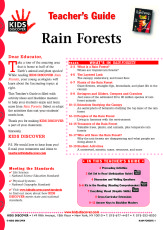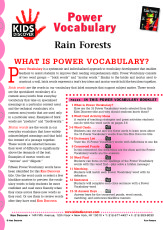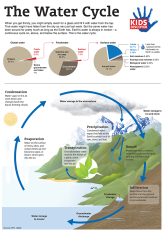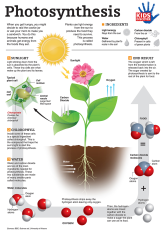What region of the world is named for female warriors in Greek mythology? Is as large as the 48 contiguous states? Contains the biggest rainforest on Earth? Is home to over 2.5 million animal species? And includes a river that spills more water into the Atlantic Ocean than any other waterway in the world?
The answer: The Amazon, a vast area that includes parts of Brazil, Bolivia, Peru, Ecuador, Colombia, Venezuela, Guyana, Suriname, and French Guiana; a mighty river basin fed by over a thousand tributaries that reach across the continent like so many veins.

At a Glance
Almost everything about the Amazon is amazing. For example:
It rains four days out of the week on average. All that precipitation can add up to as much as 400 inches a year, depending on the area. That’s over 33 feet, the height of a three-story building!
More species of plants and animals call the Amazon home than any other place on Earth. That includes millions of different insects, five times more types of fish than in all Europe’s rivers combined, and 15 percent of all the bird species in the world, not to mention the world’s biggest rodent.
The plants in the rainforest give off more than 20 percent of the world’s oxygen during photosynthesis. Oxygen is the part of air that we and all the other animals on the planet need to live.

At different times of the year, the mouth of the Amazon River may be 300 miles wide. That’s greater than the distance between New York City and Boston!
Every day, the amount of water that flows from the Amazon River into the Atlantic is enough to meet the needs of all the people of New York City—not for a day, not for a month, but for nine years!
Despite its length, not a single bridge crosses the Amazon River.

A Closer Look
If you were to fly over the Amazon rainforest, you might think you were looking down on a dense field of broccoli in full bloom. A closer look reveals a layered and complex web of life.
The uppermost part of the forest is called the emergent layer. On a flyover, this layer looks like a few broccoli stalks sticking up over the others. Many emergent trees have trunks that are 16 feet across and grow 200 feet tall, about as high as a 20-story building. These trees endure the strongest winds and highest temperatures of the forest and are home to butterflies, bats, eagles, and even some species of monkeys.

Below the emergent layer is the canopy, a dense covering of foliage 60 to 150 feet above the ground. Here the branches and leaves of trees spread out to form a roof that absorbs 90 percent of the incoming sunlight. Three-toed sloths and a huge variety of monkeys, frogs, lizards, birds, snakes, and insects live here, giving the canopy the greatest biodiversity of the forest.

Very little was known about this part of the forest until the 1980s, because it was just too difficult and expensive to study it. Getting into the canopy and staying there safely without disturbing the environment was nearly impossible.


Today, scientists explore the canopy with all manner of devices, including balloon-rafts, construction cranes, ski-lift trams, and pulley systems. Even so, there is still much to learn about the complexities of life there.

Closer to the ground is the understory, a dense tangle of vines, ferns, shrubs, and low trees. The air here is hot, humid, and still. With little sunlight, most plants in the understory have large, flat leaves that capture as much of the available light as they can. Jaguars, bats, owls, tree frogs, and an amazing variety of insects call the understory home.

The forest floor is damp and dark. Very little vegetation grows there except for moss, a few low plants, and the giant roots of the great trees that tower over the understory. The ground, littered with decomposing leaves and twigs, is home to some of the biggest inhabitants of the forest — jaguars, giant anteaters, and anaconda snakes— and some of the smallest, including millipedes, scorpions and earthworms.

The Big Deal
OK, the Amazon is big and diverse. It’s got some great-looking animals and loads of plants. But what’s the big deal???
Plenty.
Number One: Carbon dioxide
You probably know that carbon dioxide, one of the gases in air, is called a “greenhouse gas” because it traps the sun’s heat and contributes to the warming effects of climate change. Maybe you also know that burning fossil fuels like oil and coal adds CO2 to the atmosphere.
Well, during photosynthesis plants absorb carbon dioxide. Overall, the plants in the Amazon absorb nearly five percent of all the CO2 added to the air when fossil fuels are burned—and altogether the world’s rainforests absorb over 25 percent.
That’s a big deal!
Number Two: Medicine
For centuries, people native to the Amazon have been using the plants there as medicines. More recently, scientists have discovered that rainforest plants are sources for medicines to treat diseases like cancer, diabetes, arthritis, AIDS, and Alzheimer’s. In general, one in four of our medicines contains ingredients that come from a plant.

Scientists have studied only one percent of the plants in the Amazon! There may be dozens more medicines just waiting to be discovered.
That’s a big deal!
Number Three: Deforestation
To date, over one-fifth of the Amazon rainforest has been destroyed. The rate of destruction has slowed in the last few years, but until 2007 an area more than twice the size of Rhode Island was being wiped out every year.

Humans are the main cause—whether it’s human activity connected to the droughts of climate change that kill plant life, or human activity connected to the clearing of land for cattle ranching, mining, logging, and farming.

Deforestation, the clearing away of trees, is a problem for all of us. Deforestation means fewer plants absorbing carbon dioxide, which leaves more CO2 in the atmosphere to hasten climate change. Deforestation means plants possibly becoming extinct before scientists learn how they can be used to improve our lives. Deforestation means losing habitats for many thousands of animal species. It means soil erosion, water pollution, and flooding. It also means the loss of a way of life for those who inhabit the Amazon.

Many believe that losing the rainforest would do near-catastrophic damage to the planet. The World Wildlife Fund is an organization committed to conserving the Amazon Basin. Their website is full of ideas for how people can help. See for yourself. http://wwf.org/
Written by Marjorie Frank. [wp-simple-survey-19]


